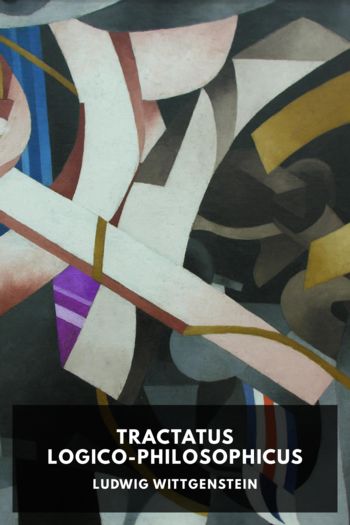Tractatus Logico-Philosophicus - Ludwig Wittgenstein (top 10 ebook reader TXT) 📗

- Author: Ludwig Wittgenstein
Book online «Tractatus Logico-Philosophicus - Ludwig Wittgenstein (top 10 ebook reader TXT) 📗». Author Ludwig Wittgenstein
The proposition determines reality to this extent, that one only needs to say “Yes” or “No” to it to make it agree with reality.
Reality must therefore be completely described by the proposition.
A proposition is the description of a fact.
As the description of an object describes it by its external properties so propositions describe reality by its internal properties.
The proposition constructs a world with the help of a logical scaffolding, and therefore one can actually see in the proposition all the logical features possessed by reality if it is true. One can draw conclusions from a false proposition.
4.024To understand a proposition means to know what is the case, if it is true.
(One can therefore understand it without knowing whether it is true or not.)
One understands it if one understands it constituent parts.
4.025The translation of one language into another is not a process of translating each proposition of the one into a proposition of the other, but only the constituent parts of propositions are translated.
(And the dictionary does not only translate substantives but also adverbs and conjunctions, etc., and it treats them all alike.)
4.026The meanings of the simple signs (the words) must be explained to us, if we are to understand them.
By means of propositions we explain ourselves.
4.027It is essential to propositions, that they can communicate a new sense to us.
4.03A proposition must communicate a new sense with old words.
The proposition communicates to us a state of affairs, therefore it must be essentially connected with the state of affairs.
And the connection is, in fact, that it is its logical picture.
The proposition only asserts something, in so far as it is a picture.
4.031In the proposition a state of affairs is, as it were, put together for the sake of experiment.
One can say, instead of, This proposition has such and such a sense, This proposition represents such and such a state of affairs.
4.0311One name stands for one thing, and another for another thing, and they are connected together. And so the whole, like a living picture, presents the atomic fact.
4.0312The possibility of propositions is based upon the principle of the representation of objects by signs.
My fundamental thought is that the “logical constants” do not represent. That the logic of the facts cannot be represented.
4.032The proposition is a picture of its state of affairs, only in so far as it is logically articulated.
(Even the proposition “ambulo” is composite, for its stem gives a different sense with another termination, or its termination with another stem.)
4.04In the proposition there must be exactly as many thing distinguishable as there are in the state of affairs, which it represents.
They must both possess the same logical (mathematical) multiplicity (cf. Hertz’s Mechanics, on Dynamic Models).
4.041This mathematical multiplicity naturally cannot in its turn be represented. One cannot get outside it in the representation.
4.0411If we tried, for example, to express what is expressed by “(x).fx” by putting an index before fx, like: “Gen. fx”, it would not do, we should not know what was generalized. If we tried to show it by an index g, like: “f(xg)” it would not do—we should not know the scope of the generalization.
If we were to try it by introducing a mark in the argument places, like “(G,G).F(G,G)”, it would not do—we could not determine the identity of the variables, etc.
All these ways of symbolizing are inadequate because they have not the necessary mathematical multiplicity.
4.0412For the same reason the idealist explanation of the seeing of spatial relations through “spatial spectacles” does not do, because it cannot explain the multiplicity of these relations.
4.05Reality is compared with the proposition.
4.06Propositions can be true or false only by being pictures of the reality.
4.061If one does not observe that propositions have a sense independent of the facts, one can easily believe that true and false are two relations between signs and things signified with equal rights.
One could, then, for example, say that “p” signifies in the true way what “~p” signifies in the false way, etc.
4.062Can we not make ourselves understood by means of false propositions as hitherto with true ones, so long as we know that they are meant to be false? No! For a proposition is true, if what we assert by means of it is the case; and if by “p” we mean ~p, and what we mean is the case, then “p” in the new conception is true and not false.
4.0621That, however, the signs “p” and “~p” can say the same thing is important, for it shows that the sign “~” corresponds to nothing in reality.
That negation occurs in a proposition, is no characteristic of its sense (~~p=p).
The propositions “p” and “~p” have opposite senses, but to them corresponds one and the same reality.
4.063An illustration to explain the concept of truth. A black spot on white paper; the form of the spot can be described by saying of each point of the plane whether it is white or black. To the fact that a point is black corresponds a positive fact; to the fact that a point is white (not black), a negative fact. If I indicate a point of the plane (a truth-value in Frege’s terminology), this corresponds to the assumption proposed for judgment, etc. etc.
But to be able to say that a point is black or white, I must first know under what conditions a point is called white or black; in order to be able to say “p” is true (or false) I must have determined under what conditions I





Comments (0)